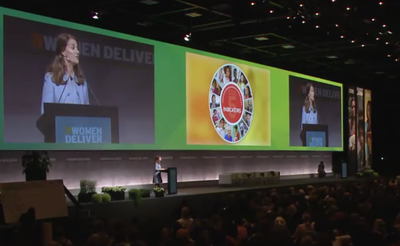Women Deliver Conference Diary
Post Number 5: De-feminizing Gender
By Brittany Schriver, MPH
COPENHAGEN, Denmark—That’s a wrap! Women Deliver 2016 has officially concluded, and with just over 5,500 participants from more than 150 countries, there were certainly diverse opinions on how to improve the current and future landscape of women and girls globally. And, one conclusion that might seem counterintuitive from a women’s conference was this: Address men.
Gender norms are created by society—meaning both the male and female sides of society. So when development programmers are planning strategies and approaches, they should consider if their program involves both men and women in order to create the opportunity for equality. When monitoring and evaluating outcomes of programs, researchers should ask if they are taking account of both genders and the effect of gender: the former through sex-disaggregated data, the latter through gender-sensitive indicators and scales.
Indicators were part of the discussion in our joint session on strategies for integrating and measuring gender in family planning and maternal, neonatal, and child health (MNCH). Along with discussion hosts—MEASURE Evaluation, the Health Policy Plus Project, and Palladium—the session was attended by representatives from universities, non-governmental organizations, and bilateral and multilateral organizations interested in gaining hands-on experience in developing appropriate strategies and metrics for transforming gender norms. When presenting findings from MEASURE Evaluation’s recent publication, Gender Counts: A systematic review of evaluations of gender-integrated health interventions in low- and middle-income countries, we reviewed the most common indicators and scales used to measure change in gender norms. These include measuring who makes household decision, and if a household member has experienced gender-based violence; we also reviewed the gender equitable men’s (GEM) scale that measures gender attitudes and expectations.
In the discussion, a participant noted that every indicator listed could be mapped to an issue of power, and so raised the question, “Is gender inextricably linked to power?”
While I’m sure others have their own opinions, I believe the current construct of gender is intertwined with power. Women often suffer from a lack of power, which affects their access to education and opportunity, the chance to make health decisions, and the likelihood of being a target of intimate partner violence. In most societies men hold greater power than women. But it stretches the point to say that all men benefit from having all the power all of the time. We have found that power among men can be tremendously burdensome and can translate into norms of machismo masculine behavior that lead to psychosocial stress, risky health behaviors, and violence. Yet for so long, we’ve only measured the impact of gender norms as they relate to women and women’s health outcomes.
This observation is not intended to pardon patriarchy, but to serve as a reality check. Both genders are affected by the power inequalities thrust upon them. So while I believe that gender’s association with power is a problem, I also believe that equality can only be achieved once this link is broken and one’s gender becomes as innocuous as one’s eye color.
Post Number 4: Counting my….Privilege
By Mahua Mandal, MPH, PhD
COPENHAGEN, Denmark—During a riveting “TED-style” talk at the Women Deliver 2016 conference about the intersection of race, class, and gender, Michael Kimmel, Distinguished Professor of Sociology and Gender Studies and founder of the Center for Studies on Men and Masculinities at State University of New York (SUNY) at Stony Brook, shared this observation:
“Privilege is invisible to those who have it.”
The paradoxical nature of privilege—that privilege can remain invisible to those in power, while those without power can remain invisible to those with privilege—is true not only among the general population, but also in the international development world. Ms. Kavita Ramdas, moderator of the TED-style session and senior advisor to the president of the Ford Foundation, implored audience members to acknowledge their own privilege even as they advocate for the recognition of the inherent worth of women and girls. Such advocacy also can help improve the health and well-being of women, girls, their families, and communities.
As development workers, becoming aware of and taking into consideration our own privilege—and our underlying assumptions about the people who are the focus of our work—is essential. Doing so enables us to design, implement, monitor, and evaluate interventions and strategies that are not only potentially successful in increasing access to services and improving health outcomes, but are also respectful, allowing people to participate in improving their own health while retaining dignity.
I work with MEASURE Evaluation, funded by the U.S. Agency for International Development (USAID) to strengthen health information systems and in-country capacity to manage and evaluate health systems. We focus on data. Data to count people, programs, health outcomes, and health status—all for the purpose of showing whether and how interventions work, and whether and how population health changes over time. We also measure various forms of inequality, discrimination, and disempowerment—in order to examine structural factors that affect the impact of programs and policies.
Taking a page from Michael Kimmel and Kavita Ramdas, I’d like to ask my colleagues to join me in doing the following: Before developing a new monitoring and evaluation framework, adapting components of a national health information system, or embarking on a new research study, ask yourself “Have I counted my privilege?”
For more information:
- Ask the Gender M&E Expert
- Gender Counts: A systematic review of evaluations of gender-integrated health interventions in low- and middle-income countries
- Making Gender Count
Post Number 3: Viva la Data Revolution!
By Brittany Schriver, MPH, MEASURE Evaluation
 I came into Women Deliver with a fair amount of apprehension. Knowing the Sustainable Development Goals (SDGs) would be the cornerstone for much of the discourse, I couldn’t help but think of the work I do with MEASURE Evaluation and wonder to what extent the discussion would focus on the data that will be needed.
I came into Women Deliver with a fair amount of apprehension. Knowing the Sustainable Development Goals (SDGs) would be the cornerstone for much of the discourse, I couldn’t help but think of the work I do with MEASURE Evaluation and wonder to what extent the discussion would focus on the data that will be needed.
In certain circles, I’ve felt resistance to the concept of gender data. From the program side, managers lament shrinking budgets and investing in data collection, analysis, and use takes away from already limited resources. From the technical research side, I’ve found opposition in disaggregating data by sex, as it, too, requires additional resources, larger sample sizes, and can be burdensome to health information systems. I wondered if I would encounter similar hesitance among my Women Deliver colleagues.
However, data and the need for better sex-disaggregated and gender-sensitive data has become a centerpiece of this year’s Women Deliver conference. We have heard of the gender gap in civil registration and vital statistics (CRVS)—when and where women are born, or how, when, and where they die is often not recorded. We have heard of the lack of information on women’s health burden in certain technical areas such as TB and malaria. And we have discussed the ever-growing gender gap in the workforce. Even as the numbers of women in the workforce grow, women’s and men’s household responsibilities remain the same. Women now make up 40 percent of the global workforce, yet spend twice as much time caring for children as do men. Often, this informal economic contribution goes unrecognized in our data systems.
In her keynote speech at Women Deliver Tuesday (May 17), Melinda Gates, of the Bill & Melinda Gates Foundation, said, “Gathering and analyzing data is about bringing visibility to the invisible.”
Women and girls will continue to remain invisible if we do not count them in our data systems. This is particularly true of our routine health systems, which aggregate data at a granular level, often at the health facility level. It becomes impossible to determine if gender gaps exist, when at the population and service delivery levels we cannot measure the differences between men and women and the health care they seek and receive. Without equitable data, we cannot make equitable decisions.
With this in mind, Melinda Gates announced that the Gates Foundation would dedicate $80 million to enhance and expand gender data. As we move from lip service to actually seeing change makers and donors commit to the importance of measuring, I say VIVA LA DATA REVOLUTION!
Post Number 2. Take What You Need
By Brittany Schriver, MPH, MEASURE Evaluation
COPENHAGEN, Denmark—We’ve arrived in Copenhagen and naturally we’re running about trying to prepare ourselves for our session and the conference as a whole. We’re staying in a home near the conference venue but a bit out from the city center. There are not many tourists on this side of the city and English is not common, so I was somewhat taken aback when I passed this sign.

Every tab had been pulled off. Clearly, whatever Copenhagen’s offering, people need.
Sometimes what people need can’t be found on a street pole advertisement. For most of the world’s women and girls, what is needed is equitable access to education and healthcare, freedom from violence, value in the community and economic spheres, and equal rights under the law. Women Deliver 2016 is an incredible forum for activists, world leaders, policy makers, researchers and others to come together to focus on the health, rights, and wellbeing of girls and women—and the largest such gathering in more than a decade. This conference allows participants to share their experiences, opinions and insights and discuss key solutions to achieving the ambitious Sustainable Development Goals.
And yes, I’m here because I need something. I need to know that when we commit to lofty goals for development, we have systems in place that not only get us toward achieving this goal but tell us if and when we’re getting closer. We need monitoring and evaluation (M&E) systems that that are not only generating data, but generating data that is needed to measure progress. At my project, MEASURE Evaluation, funded by the U.S. Agency for International Development (USAID), I’ve worked with partners who collect an amazing amount of data—however, not all of it is useful or used.
I’m thrilled to see that in this conference there are several sessions over the next few days on data for achievement and advocacy. I’ll be interested to hear and contribute to the discussion of when and where to prioritize gender data in programs and policies.
I hope to take from this conference exactly what I need and perhaps give a little as well.
Stay tuned for updates on my experiences, thoughts and session recaps from Women Deliver 2016. Or, follow live on Twitter: @MEASURE_Eval and @bschriv.
Post Number 1. Delivering Data at #WD2016
By Brittany Schriver, MPH, MEASURE Evaluation
 CHAPEL HILL, NC—Women Deliver brings together world leaders, advocates, policymakers, journalists, young people, researchers and leaders of the private sector and civil society to showcase what it means and how it works when women and girls become the focus of development efforts. I’ll be traveling next week to the fourth such conference held in Copenhagen from May 16–19. It will be the largest gathering for more than a decade, and one of the first major conferences following the launch of the Sustainable Development Goals (SDGs) that aim to end poverty, improve health, and combat inequalities.
CHAPEL HILL, NC—Women Deliver brings together world leaders, advocates, policymakers, journalists, young people, researchers and leaders of the private sector and civil society to showcase what it means and how it works when women and girls become the focus of development efforts. I’ll be traveling next week to the fourth such conference held in Copenhagen from May 16–19. It will be the largest gathering for more than a decade, and one of the first major conferences following the launch of the Sustainable Development Goals (SDGs) that aim to end poverty, improve health, and combat inequalities.
While there, I’ll help lead an event hosted by my project, the USAID-funded MEASURE Evaluation project, the Health Policy Plus (HP+) project, also USAID-funded, and Palladium. This session is open to all Women Deliver participants and is particularly relevant for NGOs, universities, donor organizations, and governments wanting to build skills in integrating gender in the design, implementation, and monitoring and evaluation of family planning and maternal, neonatal, and child health (FP/MNCH) policies and programs in low- and middle-income countries.
This event will share findings related to FP/MNCH from Transforming Gender Norms, Roles, and Power Dynamics for Better Health, a systematic review of gender-integrated programs in low- and middle-income countries. The review was undertaken by the event sponsors, along with the Public Health Foundation of India (PHFI), and the International Center for Research on Women (ICRW). We’ll discuss evidence-based strategies for transforming gender norms, roles, and relationships for improvements in health programs and outcomes.
We’ll also examine how these gender-integrated programs are monitored and evaluated and share findings from another recent publication, Gender Counts: A systematic review of evaluations of gender-integrated health interventions in low- and middle-income countries. This review assesses published, peer-reviewed evaluations of gender-integrated programs with regard to their theories of change, study designs, and gender integration in data collection, analysis, and gender measures used. Importantly, it found that existing evaluations vary considerably in their conception, design, and implementation.
Understanding the methods currently used to determine success in addressing gender in health programs provides a foundation for discussion and consensus-building around approaches and measures for gender integration. Additionally, identifying what information is not collected, or is under-collected, is equally important to improving how programs and policies address gender.
Women Deliver provides a platform to discuss the gender data gap and what will be needed to demonstrate achievement towards the SDGs, women’s empowerment and gender equity in health programs. I also look forward to moving the discussion beyond sex-disaggregated data and data that affect women and girls exclusively. While such data are essential to understanding when and where differences exist between men and women, they are inadequate to explain why these differences occur or propose opportunities for change. It takes qualitative and quantitative approaches to measure gender norms and expectations, the traditional roles of men and women, and the changes in relationships that occur. For example, a program to encourage men’s participation in family planning can quantitatively measure if there is an increase in men’s access to FP services. A qualitative approach can describe if there are changes in traditional expectations of masculinity that contributed to such health-seeking behavior among men.
Stay tuned for updates on my experiences, thoughts and session recaps from Women Deliver 2016. Or, follow live on Twitter: @MEASURE_Eval and @bschriv.















